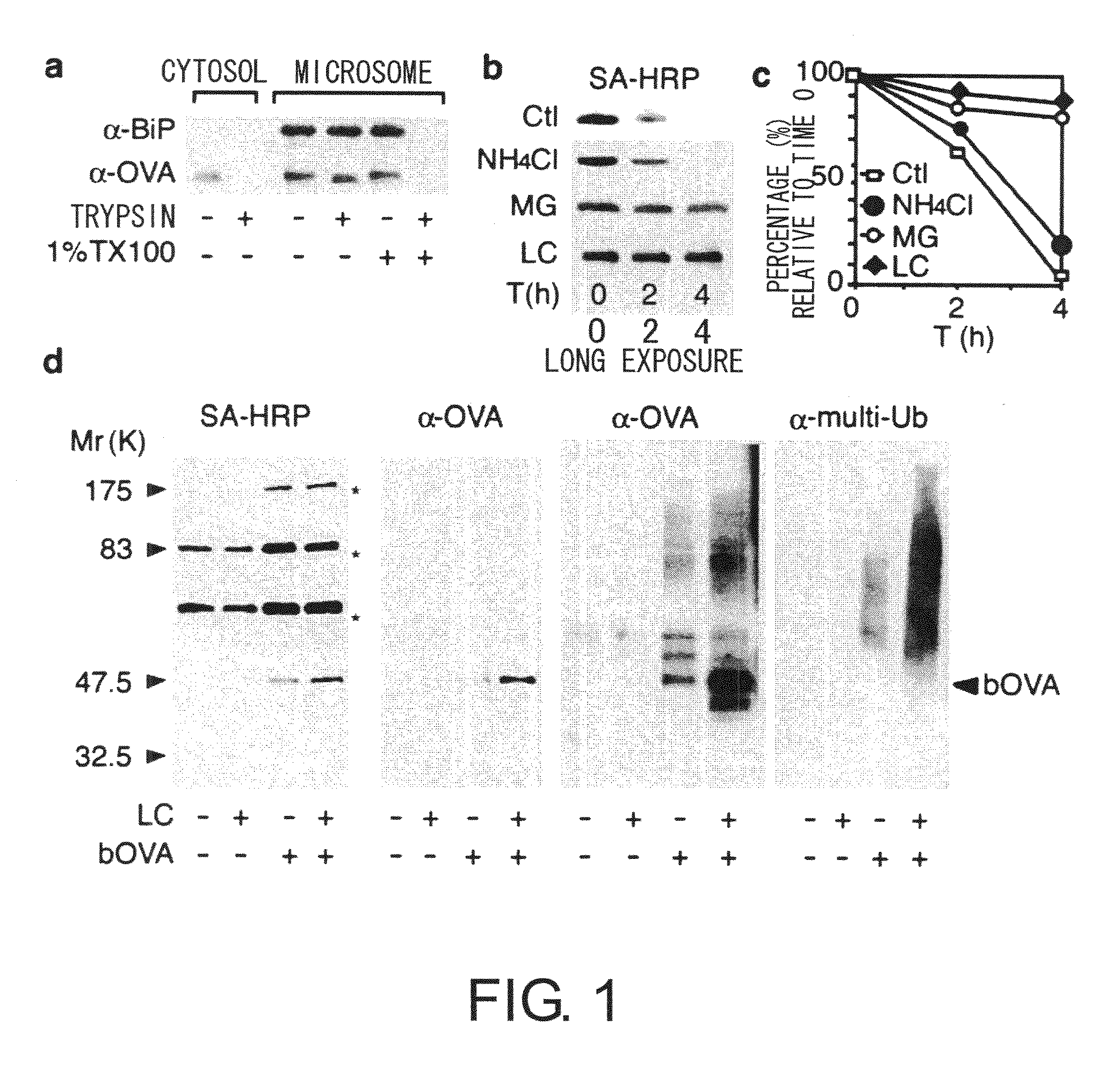Methods For Producing Dendritic Cells That Have Acquired Ctl-Inducing Ability
- Summary
- Abstract
- Description
- Claims
- Application Information
AI Technical Summary
Benefits of technology
Problems solved by technology
Method used
Image
Examples
example 1
Proteasome-Dependent Degradation of Accumulated OVA
[0094]Intracellular localization of foreign antigens was examined by cell fractionation methods. Chicken ovalbumin (OVA) was used as an antigen model, and DC2.4 (haplotype H-2Kb), a cultured cell line of mouse dendritic cells, was used as a model for dendritic cells. The DC2.4 cell line is derived from dendritic cells, and was established while retaining many of the properties of dendritic cells, such as cross-presentation. BMDCs with a haplotype of H-2Kb, the same as that of DC2.4, were used as the control. BMDCs were induced from the bone marrow cells of C57BL / 6 mice (SLC) in RPMI-1640 supplemented with 5% FCS using 5 ng / mL GM-CSF (MEL), and those cells purified by magnetic beads after five days of culturing were used.
[0095]DC2.4 cells made to take up bOVA antigens were suspended in 10 mM Tris-HCl (pH7.4) containing 250 mM sucrose, this was homogenized using glass beads, centrifuged for 30 minutes at 250,000×g, and then fractionat...
example 2
Relationship Between Accumulated OVA and ERAD-Related Proteins
[0100]To prove the above-mentioned hypothesis, first, the relationship between accumulated OVA and substances involved in retrograde transport from the ER to the cytoplasm was examined by co-immunoprecipitation. 2×107 DC2.4 or BMDC cells were cultured for four hours in a medium containing 10 μM MG-132 in the presence of bOVA at 250 μg mL−1. Cells were lysed in 20 mM HEPES pH7.6 containing 1% digitonin and protease inhibitors to collect biotin-labeled samples. The samples were cleared of impurities in advance using protein G sepharose (Amersham Pharmacia Biotech), and after incubation with antibodies for precipitation (anti-Sec61β, anti Sec61α, anti-VCP, anti-BiP, anti-PDI, anti-calreticulin, anti-TAP1, and anti-TAP2), the immunoprecipitates were collected using protein G. When chicken anti-CHIP antibody was used, immunoprecipitates were collected using a rabbit anti-IgY column (Mr. S. Seki, MBL). The precipitated samples ...
example 3
Decrease Caused by ERAD Inhibition of the Degradation of Accumulated OVA
[0105]Next, to further confirm the involvement of ERAD, the effect on bOVA accumulation of ERAD inhibition, for example by Ca2+ depletion or thapsigargin treatment, was examined. Depletion of Ca2+ in the ER is known to inhibit ERAD. Thapsigargin (Tg) is known to decrease the Ca2+ concentration in the ER lumen by binding to the ER membrane and functioning as an ionophore and to inhibit ERAD. Thus, in the presence of Tg, bOVA degradation by ERAD is predicted to be suppressed. DC2.4 cells were pulsed with bOVA in the presence of MG-132, then washed with PBS or with PBS containing 1 mM EGTA, and then chased for four hours. As shown in FIG. 4a, accumulated bOVA did not decrease with Ca2+ depletion. Re-addition of Ca2+ to cells pre-exposed to EGTA restored bOVA degradation (FIG. 4a). This eliminates the possibility that Ca2+ depletion caused irreversible damage to DC2.4 cells. Thapsigargin also inhibited the degradati...
PUM
| Property | Measurement | Unit |
|---|---|---|
| Antigenicity | aaaaa | aaaaa |
Abstract
Description
Claims
Application Information
 Login to View More
Login to View More - R&D
- Intellectual Property
- Life Sciences
- Materials
- Tech Scout
- Unparalleled Data Quality
- Higher Quality Content
- 60% Fewer Hallucinations
Browse by: Latest US Patents, China's latest patents, Technical Efficacy Thesaurus, Application Domain, Technology Topic, Popular Technical Reports.
© 2025 PatSnap. All rights reserved.Legal|Privacy policy|Modern Slavery Act Transparency Statement|Sitemap|About US| Contact US: help@patsnap.com



